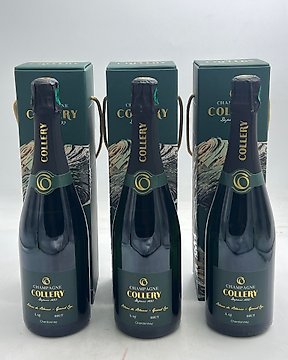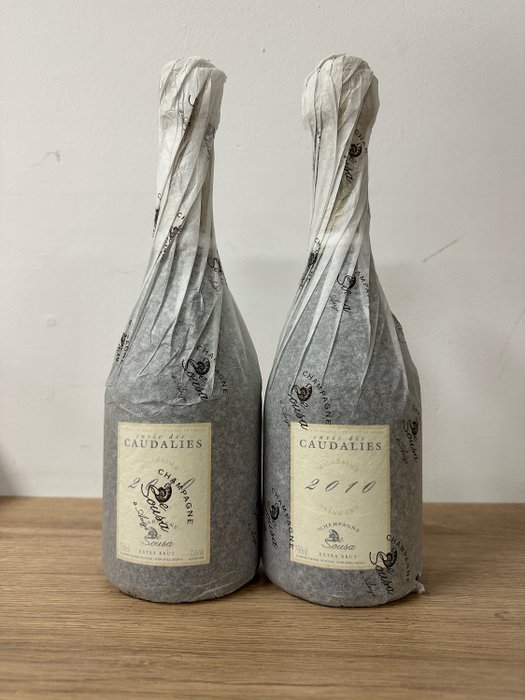
Collery, Blanc de Blancs - Champagne Grand Cru - 3 Flasker (0,75 L)
Nr. 83635831

Nr. 83635831

The Côte des Blancs is the center for Blanc de Blanc production within the Champagne region. "The Hill of Whites", to the south of Epernay, is an east or southeast-facing slope around 15 kilometers (9 miles) in length. Its chalky soil is more suited to white grape growing production than the more clay-based soils elsewhere. 96 percent of vineyards here are planted with Chardonnay.
Blanc de Blanc Champagnes tend to taste different to the most familiar non vintage cuvées. Those usually include considerable proportions of black-skinned Pinot Noir and Pinot Meunier. That said, it is hard to identify any stylistic characteristics that are common to all Blanc de Blancs bottlings.
This is true when one tastes those few wines made from less common white grape varieties (see below). Chardonnay does tend to taste more citrussy than wines with red grape components. They tend to be (or appear to be) crisper and drier and more likely to be considered as an aperitif or partner to seafood. Still, there is also considerable variation between wines made only from Chardonnay.
Even within the Côte de Blancs, terroir variations seem to play a strong role. For example, A. Jacquart's Le Mesnil cuvées emphasizes acid structure, elegance and minerality. But their Premier Cru Vertus, from the southern end of the Côte de Blancs, is much rounder and more peach-laden.
Le Mesnil sur Oger is a Grand Cru-rated commune within the Côte de Blancs. (In Champagne villages gain Premier or Grand Cru status, not individual plots). Salon's Le Mesnil and Krug's Clos de Mesnil are made entirely from Chardonnay grapes sourced from here. Other Blanc de Blanc Grand Cru villages are Cramant, Avize and Oger.
The Côte de Sezanne zone lies a little to the south of the Côtes de Blancs. It is also southeast-facing and has a similar focus on Chardonnay. But the heavier soils tend to produce wines with a little less finesse.
Maturity can also play a role in how a Blanc de Blancs tastes. Chardonnay-based wines can show more citrus, green apple and minerality when young. They often gain honeyed, buttered toast characters in time. Top quality blanc de blanc vintage Champagnes are among the longest-lived of any category of sparkling wine.
It follows that the amount of reserve wine in any non-vintage Champagne can play a big part in the style. Other important winemaking considerations include whether the base wine saw any oak and the length of maturation in the bottle with the spent yeast before disgorgement.
The sweetness of the wine as determined by dosage is also important. Wines made only from Chardonnay are likely to undergo malolactic fermentation, as with other styles. However, Salon (which needs time in the cellar) is one example where the process is suppressed.
The Other Grape Varieties
Only a few producers use the other four grape varieties that the appellation laws permit. These are Pinot Gris, Pinot Blanc, (also known as Blanc Vrai in the region) Petit Meslier and Arbane. They account for only a fraction.
Michel Drappier's Quattuor is, as the name suggests, produced from Chardonnay, Arbane, Petit Meslier and Pinot Blanc. Duval-Leroy's "Authentis Petit Meslier" Champagne is notable because it is made purely from Petit Meslier. Jancis Robinson's tasting notes for the Authentis describe the wine as "very floral with some green leafy notes".
Moutard Pere et Fils "Cépage Arbane" Champagne is made from perhaps the most obscure of the Champagne grapes. Increasingly rare, Arbane has never spread very far. It now exists in just a few acres of vineyard in the Cote des Bar district (Moutard's homeland), in southern Champagne. Moutard also use the variety in their Cuvée Six Cépages Brut, alongside five other varieties.
Cedric Bouchard's Roses de Jeanne range contains several single-variety Champagnes, two of which are Blancs de Blancs: La Bolorée (100 percent Pinot Blanc) and La Haute-Lemblée (100 percent Chardonnay). These wines have been met with adoration in various circles, and have earned Bouchard a solid reputation among Grower Champagne producers.
Sådan køber du hos Catawiki
1. Opdag noget særligt
2. Afgiv det højeste bud
3. Foretag en sikker betaling